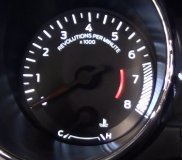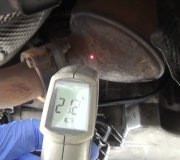Chrysler has built, and is still building some of the toughest and most reliable engines, but you're right, the 2.7L isn't one of them.
Since you're talking a lot about head gaskets, I'll start with that. Some of your research relates to common misconceptions. The first is the milky-colored oil from coolant getting into it. While that can happen, it is by far the least common type of head gasket failure. You're asking coolant under 15 pounds of pressure to go through a leak into an oil passage either pressurized to 45 psi, or into an oil drain back passage with 0 psi. Pressurized oil would flow into the coolant and show up under the radiator cap or as a thick, gooey film in the reservoir. Either way, the pressures are very low, so mixing of the fluids is not common.
By far the more common head gasket symptom is combustion gases sneaking into the cooling system. During the power stroke, cylinder pressures go very high, so it's more likely some gas will get through a head gasket leak. The coolant passages are closest to the cylinders, so the gases will go into the cooling system long before they go into an oil passage.
I'm not familiar with the packets of dye you described. It's normal for very small amounts of combustion gases to find their way into the cooling system, so I wonder if your method might produce false results. One of the biggest problems with cooling systems is acids build up over time. Those are neutralized by one of the important additives in antifreeze. Those additives used to wear out in about two years which is why we always preached about replacing the coolant every two years. Today the additives last longer, but the fact remains, you can get combustion gases in the cooling system over time. You'll find may different types of metals in the cooling system. Those can include steel cylinder blocks, aluminum cylinder heads, brass, lead, and tin in the radiator and heater core. Any two different metals and an acid is in effect, a battery. They work by "galvanic action", meaning corrosion. Worn out antifreeze additives is a common cause of corroded head gaskets.
The better approach when checking for a leaking head gasket is to use a leak "sniffer". This article shows how it is done:
https://www.2carpros.com/articles/head-gasket-blown-test
They get to the pertinent part in step 4. You can borrow this tester from any auto parts store that rents or borrows tools. In my city, they make you buy the tool, then you get a full refund when you return it. If you choose to keep a tool, you still return it, then they order or give you a brand new one. The fluid for this tester is a different story. You will have to buy a bottle that you keep. They do that because it will be rendered ineffective if it freezes or if it becomes contaminated with coolant. They don't want to risk the previous person contaminating the fluid, then they borrow the tester to you that way.
Some models of this tester have two chambers with fluid, but they work the same way. You can see for yourself how the fluid changes color by simply "talking to it". The carbon dioxide in your breath makes the fluid turn bright yellow. Next, when you squeeze the bulb repeatedly, the fluid will return to dark blue. It can change back and forth and be reused over and over until it becomes contaminated.
You also mentioned overheating which is another good clue. If the leak is bad enough, the gases can pool under the thermostat causing it to not open. Thermostats have to be hit with hot liquid to open. Hot gas won't do it. Another concern is in most engines, the thermostat is "over here", while the heat being generated is "over there". It can take too long for the heat to migrate over to the thermostat. To address that, most thermostats have a very small bleed hole in them. Those allow just enough flow to take place so the hot coolant gets over to the thermostat in time for it to open. When you have a small combustion gas leak, the gases can pass through that bleed hole fast enough so the thermostat still operates and opens normally. To say that a different way, for enough gas to pool under the thermostat to cause engine overheating, the leak has to be substantial. It should show up with the leak sniffer.
Replacing head gaskets is, in my opinion, too involved for the average competent do-it-yourselfer, especially if you think you're going to do this over the weekend, then you need the car for work Monday morning. Slapping in new gaskets is just one part of a proper repair. Professionals will use a precision straight-edge and feeler gauges to check for flatness in multiple directions. Proper surface prep is critical for gasket sealing. More than just scrubbing the surfaces clean with air-powered tools, the specified "surface finish" must be achieved to make the right size scratches for the gasket to bite into. It's also critical to use an accurate click-type torque wrench when tightening the bolts, particularly the cylinder head bolts. They must be tightened in steps, and in a specific order. This is all spelled out in the service manual. I can post those instructions for you, but it will take some time to format them so they can be uploaded.
If a head is found to be warped or is too uneven, it must be replaced. Many years ago it was common to machine them to make them perfectly flat, but today, most engines use overhead camshafts that ride on machined surfaces on top of the head. Those surfaces must be in perfect alignment. They are not when the head is warped. Machining the head gasket side leaves the camshaft journals out of alignment. That forces the camshaft to bend back and forth as it rotates. Eventually it will break. Rare or expensive cylinder heads are repaired by clamping them to a fixture with a shim under the high spot, then it is heated for a long time in an oven. For more common heads like yours, it's much less expensive to just buy a new one.
For leaks where the exhaust manifold bolts to the engine, a major clue is you often will not hear anything while standing next to the running engine, but you'll hear a loud ticking noise during periods of moderate to hard acceleration. Engine mechanical ticking is usually not heard at that time because it is drowned out by engine and wind noise. A secondary clue that can show up with an exhaust leak is a diagnostic fault code for "Bank X running too lean". During the exhaust strokes, exhaust gas is pushed out through the manifold and pipes. During the times there is no exhaust stroke taking place, the momentum of the gases flowing out can create pulses of vacuum behind it. Those pulses can draw in outside air through the leak. The oxygen sensor can see that unburned oxygen and report it as running too lean on that side of the engine.
Failure to have a "lean" code set does not mean there can't still be an exhaust leak. The code is just one more potential clue to look for.
There is one bright spot to consider. I found this out from a friend repairing his mother's Sebring. He figured out that if you need to replace the engine, you can use the much better 3.5L instead. It bolts up to the transmission and engine mounts the same way. It also uses the same Engine Computer and wiring harness, so it's basically a drop-in replacement with no alterations or programing required. Use the injectors that were in the 3.5L in case they flow different volumes compared to those in the 2.7L.
Let me know how far you get and if there's more questions.
Saturday, December 9th, 2023 AT 6:59 PM


